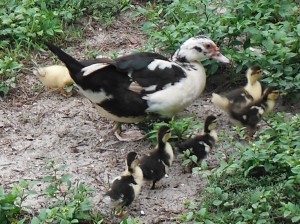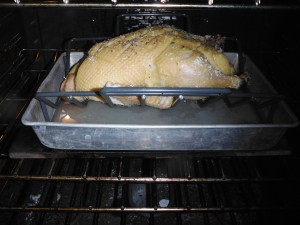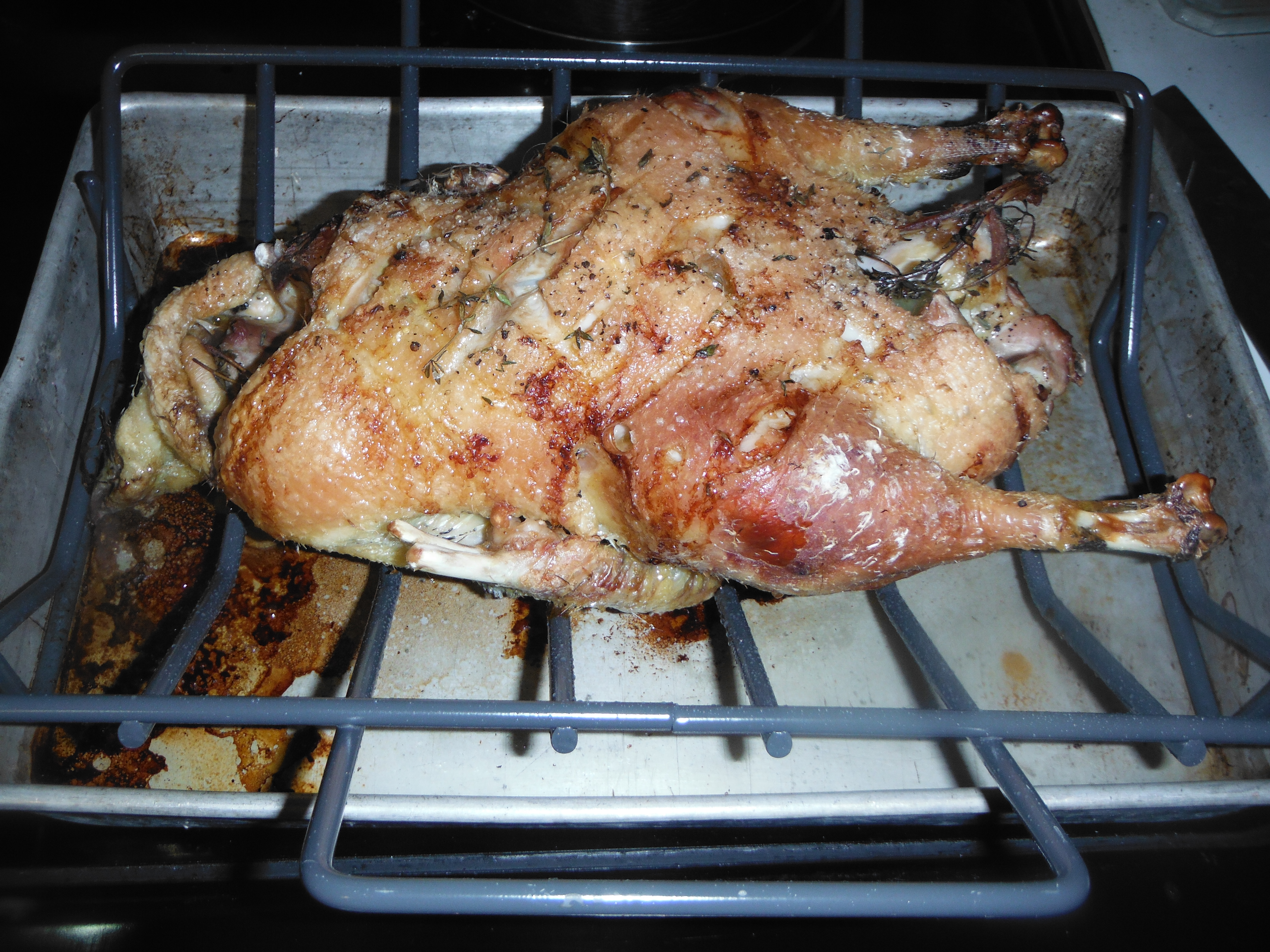For the faint of heart, and/or the vegans. Be warned that this post includes descriptions and video of animals being dispatched for food. If you don’t like the thought of facing your food, don’t bother to read any further. I’m not writing this to make friends, or enemies. I’m writing this because some folks want to get back in touch with the skills we’ve lost. Vegans, please click here instead. Soft-hearted tree huggers, click here.
You’ve been warned.
I picked up 4 Muscovy ducklings about a year ago, in hopes of getting Muscovy ducks started in my yard for eggs, meat, and pest control. Two of them made it to adulthood, mostly by NOT jumping the fence into the neighbors yard full of dogs, unlike the two I lost. And somehow, I ended up with a male and a female. As things things usually go, fast forward about 5 months, and I ended up with 10 baby ducks.
And somehow, I ended up with a male and a female. As things things usually go, fast forward about 5 months, and I ended up with 10 baby ducks.
Oh Happy day! I had succeeded in producing my own ducks! OK, in letting it happen on its own. Muscovies are very self-sufficient, and need almost zero input from me on a daily basis. Water and a place to forage, and they’ve been happy.
Now that they have started to feather out, I thought it would be a great time to see just how worthwhile they are as eating birds.
Choosing one of the largest ducklings, typically indicating that it was a male, I quickly cornered and capture him…
Let me pause here, and state once again, that I get no joy from killing animals. I choose to raise animals for my own consumption (see this post of mine for more details), and having grown up doing so, prefer to dispatch and process them myself, since nobody else would take as much care in processing MY food as I would. Let’s just say I trust very few to handle my food. Good cooking can only go so far to cover up poorly handled food. (See FHP Tip #4) On the other hand, properly handled animals protein almost always yields a better end product.
Back to my freshly captures Muscovy drake.
Using the same method that I use for dispatching chickens, I hung the bird upside down from a loop of paracord around both feet. The bird quickly calms down, I’m guessing from too much blood to his brain. Whatever the reason. The bird remained calm.
Last chance for the squeamish…
Using my stainless steel Mora, freshly sharpened, I make a smooth, quick slice across the jawline of the bird, cutting through its jugular vein and carotid artery. This allows the bird to quickly bleed out with a minimum of trauma. I was also told this is the Biblical method for slaughtering animals, and that while dying, the animal struggles, shakes and kicks, not due to pain, but due to the contraction and relaxation of the muscles deficient in blood and due to the flow of blood out of the body.
Once the bird had bled out, I then cut off the head.
Here was my first lesson. I thought I’d try to pluck the bird dry, without scalding it first. Scalding is a pain, as I have no good method of heating water outside, so mush heat it inside, then carry a pan of almost boiling water to my harvest station. About twenty minutes into this lesson in futility, I called asked my wife to start a pot of water boiling while I continued to work at removing the stubborn feathers. Once I scalded the bird, it all became MUCH easier, though still quite a hassle. I plan to make a rotary plucker eventually to help in this task.
Once plucked, I then cut around the vent to start removing the organs. Once cut free, I remove the “exit hole” with some of the surrounding tissue (I don’t want to eat THAT!), and pull out the intestines, being sure to save the gizzard, heart, and liver (being sure to remove the gall from the liver, btw).
I also cut across the base of the neck just through the skin, in order to help remove the rest of the entrails from the front of the body cavity, being sure to remove the lungs as well.
I repeated the same process with a second Muscovy, only this one I skinned instead, to compare the end results.
Rinse, soak, then go over again, getting all the pin feathers I missed from the plucked bird.
I allowed them to sit in lightly salted water for a couple days, then using a sharp knife, cut very light slashes through the breast skin. I then rubbed in liberal amounts of fresh thyme, salt, and pepper. I stuffed the body cavity with a quartered lime (it’s a Florida thing) and the remaining thyme I had.
Placing it on a roasting rack in a pan, I then put it into the oven preheated to 350 degrees for an hour and 15 minutes. At that time, I then turned up the heat to 450, then roasted it for another 30 minutes to crisp of the lovely skin.
While the skin-on bird was roasting, I took the skinned bird, and filleted the breast portions off. Dusting them with sage, salt, and pepper, I then gave them a quick sear on both sides for about 2-3 minutes per side in a pan of butter on medium high heat. The fillets I then sliced across the grain after about ten minutes of resting, then tasted them.
Wow. Holy Wow! Sweet, yet not overpoweringly so. Odd, too since I added no sweetener to the birds. Not quite like chicken, but also not greasy like duck. Superb seems to fit the bill very well. My only complaint was how small the breasts were. In retrospect, the birds were only about 10 or 11 weeks old, so on the young end of the scale for prime harvest age. I understand that 12-14 is the better age to start harvesting, but I had a window of opportunity to give this a try. I also have 6 more birds waiting to be harvested, or added to the breeding stock. I’m thinking a little of both!
As to the roasted duck, the skin came out fabulously crispy, better than any home made pork rind. Again my biggest complaint was the overall size of the bird, something I can remedy easily.
 And as to the organs I saved, I sliced the heart and liver up, dusted them with sage, salt, & pepper too, then fried them in butter. I believe I like duck liver better than rabbit liver! Oddly, both organs were also a bit on the sweet side. Nice!
And as to the organs I saved, I sliced the heart and liver up, dusted them with sage, salt, & pepper too, then fried them in butter. I believe I like duck liver better than rabbit liver! Oddly, both organs were also a bit on the sweet side. Nice!
As to the remains of the skinless bird, I quartered that, then slowly simmered it for 3 hours in wine with some salt, pepper, and sage. This I shredded like pulled pork after it was drained, cooled and deboned. I was supposed to mix it with fat as a sort of bread spread, but it never had a chance, once I tasted it.
What did I learn?
- Scald birds and pluck them over skinning – the skin is SO worth it!
- Get a plucking machine of some sort.
- Let the birds mature a bit more. Older birds are larger birds, yielding more.
- Muscovies are well worth the trouble. I’ll be keeping them as a regular part of my urban-stead.

Excellent video! Informative, and the “silent movie” style works really well for the purpose.
Didn’t have much choice on the audio, I did it all about 15 feet from my house AC unit, and it was NOT quiet. The wind wasn’t helping either. And I was listening to Slaid Cleaves, a habit I’ve developed while harvesting my animals. I listen to “Twistin”, “Lydia”, “One Good Year”, and “Breakfast in Hell”. Look him up on Youtube, he makes some mighty fine music.
And thanks for the kind words
db
I’ve always skinned and fried the breast meat and boiled the rest like you did never tried to roast a muscovy! Wild wood ducks are terrific though! I think it’s what they eat
Then mine must be eating the sugarcane I”m growing in my back yard. (Crazy that I can grow my own sugar here)
Either way, these guys are TASTY!
Great job. So hopefully we can get one video a week??..;-)
Not having killed or dressed anything since I was like 13, what’s the advantage of slitting the throat vs just wacking off the head???
Not as traumatic…to me, for one thing
They flop like nobody’s business when you wack off their head…spooks me…I did use my rabbit wringer on the second duck, not much flopping, it just didn’t bleed out. Maybe cervical dislocation in conjunction with wacking off the head might be a decent combo
You slit the throat rather than chopping off the head so that the heart continues to beat and pump out the blood.
How do you provide ‘swimming’ areas for the ducks, and what about shelter. I was hoping that there would be more info on how to raise the ducks.
Ray
Thanks for the clarity as to why to slit the throat Ray. Now that I’ve read that, it makes perfect sense.
As to the swimming area and housing, I’ve touched on those subjects from time to time
here: http://floridahillbilly.com/my-choice-in-animals-for-urbansteading/
and here: http://floridahillbilly.com/baby-duck-not-the-wine/
as well as several other blurbs.
But in answering your interests, being a tropical “duck”, from the family, Anatidae. The Anatidae are the biological family of birds that includes ducks, geese and swans, but are a small offshoot with only two species in it, and the other one is possibly mis-classified (http://en.wikipedia.org/wiki/White-winged_Duck).
Muscovy are tree perching ducks, with webbed feet and prominent claws.
They require water for drinking only, not for swimming, although they do play in the water, if available. Unlike many other ducks, water is not required for mating.
MY personal experience with Muscovy ducks only pertains to Florida, so I can only go on the words of others, in that they require no more shelter than any other farm bird. Mine have a small dog house to shelter in if needed, but rarely use it, opting to shelter wherever they end up at the end of the day, normally on the north side of my shed, under my rabbit cages.
I’ve decided to keep my ducks and chickens separate due to my drake being much larger than the chickens, and not seeming to care about crossing species lines for his love interests. I lost several chickens to his enthusiastic methods, sadly.
As to predation, I have a dog that has free access to the entire yard, and doesn’t harm any of my animals, but plays hell on cats, possums, raccoons, bobcats and squirrels. Not sure how she knows, as she is a Pit bull, not a typical livestock guardian dog breed, but I’ve not lost an animal in my yard since I’ve added the dog.
I hope all this helps, Muscovies have a bad reputation around here, one I’d like to help resolve. They are fun to watch, great on eliminating flying pests, won’t tear up a garden like chickens do, lay great eggs, are great mothers, are very self-sufficient, and taste great. I’ve spent less than a year with mine, and have decided that I’ll be having them as part of my livestock for as long as I’m able to do so, and I”m probably more likely to keep the Muscovies than chickens, if I had to choose between the two.
db
We have 24 Muscovy’s, and about half of them are males. They are almost 12 months old and we’ve been thinking about harvesting them. We live in Arkansas, and have never processed our own animals before. This was an excellent video showing us what to expect. Thank you, thank you, thank you! Your experience has really encouraged me to try this.
Not sure if I mentioned it, that was my first attempt at harvesting a Muscovy….
Just do it! I cannot stress how tasty they are! You will be happy that you went through with it.
I will say that rabbits are FAR easier….no feathers!
I have a question. What age is a good or bad age to eat the duck. I have some Cayuga and I bought them six months ago. Whats the typical for this same questions ab out the chickens.
The only thing I can offer is the older the bird, the larger the yield…and the harder to pluck. Older also gives tougher meat, though not horribly so.
Same goes for chickens.
Its up to you to decide what age is large enough to be worth harvesting, but still easy enough to not be a huge pain to do. I like 3-4 months on ducks. Chickens will depend on breed….
Watch the video, like how you cleaned and gutted in the air. Tried that today and it went very smooth. Problem, dealing with a black Muscovey male, little under no more then 3 months. Lucky to have a nice chicken plucker, soaked them in the water, concerned about to hot and cooking the skin. Either way soaked it up and down, pulled the wing feather and then into the plucker. It came out horrible, did’t remove the feathers, pin feathers, or even the down. A lot of work to make it look good. Any thoughts on what I might be able to do different? Also, the females being smaller, are they worth doing? Do you let them grow a little longer to get them little bigger? Thank for any input or thoughts on the subject.
b
How to make it easier? Skin them!
Are they worth doing? They taste fantastic, in my opinion, so yes, I’d say that they are…I also understand that they are easier to clean when the adult feathers just start to come in, but the yield is less, since they are younger birds.
If I had it to do all over again (I only have quail right now), I’d harvest at a younger age, and be happy with a smaller, easier to clean, carcass.
db
Thanks for the input. What age would you say is that ideal age? I looked up waxing, so I am wondering have you ever tried that?
Ideal age would depend on growth rate…watch for the adult feathers to start coming in, they look like little darts. You’ll recognize them as soon as they appear, I promise. At that point, I’d start boiling water and getting a knife sharpened.
I’ve not waxed birds before, though I understand duck hunters do it with great success.
Howdy from the Pacific North West,
Great Video.
Your comments and instructions were straightforward and informative. I noticed you took a good amount of time to produce this clip.
However, the way in which you ended your muscovy’s life, was in my eye, not the best. Perhaps, it’s the way for chickens in which you’ve had success. In my experience there are ways of putting the chicken to ‘sleep’ under your arm before you cut its throat so that it’s unaware of the deed. Your Muscovy suffered over 2.5 minutes and it was difficult for me to watch even though Ive had experience with this before.
I would recommend severing it’s entire head with one swoop and letting it bleed out afterwards. Ducks have similar fear reactions of intuition.
In any case, I think this a great video and felt as if you portrayed the steps well – I learned a good amount from it.
I wanted to add my two cents since it was your first time and you seem to be pretty pragmatic with your processing.
Cheers,
Julian
If you read through the comments on Youtube, you’ll find it was a trial, and I’ve found I don’t care for it, causing many of the concerns you’ve outlined here. It was far from the first animal I’d ever processed, but it WAS the first time I’d ever used THIS technique. I’m a firm believer in that for the most part, for one creature to live, other organisms must die. Be happy you are as far us the food chain as you are….
Peace,
db
wow, this is exactly what i was looking for, super helpful, thanks.
You are welcome…and rather vague